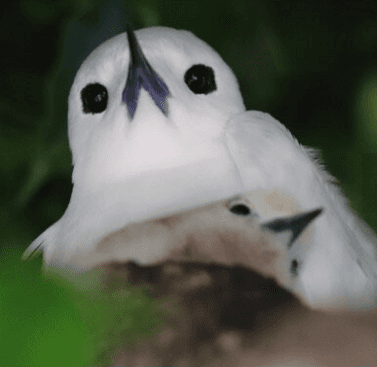Manu-O-Ku The White Fairy Tern of Honolulu
Share
Manu-O-Ku

Photo from nawaiekolu.org
I love learning new things, and this week I was fortunate enough to meet a woman who taught me something new about a bird that I’ve been seeing for years!
Many of you may have seen the white birds that live around Honolulu and often fly out above the ocean. They move quickly and hang out in the trees in Town, as well as in the lineup at many of our surf spots, such as Kewalos (where I often see them). These birds are called the white fairy tern and are native to Hawaii. In fact, they were known to Hawaiian navigators as the manu-o-ku and were used to help find the way back to land. The white tern flies out to sea to fish in the morning and flies back to land to nest at night, so depending on the time of day and what direction the manu-o-ku were flying, indigenous seafarers were able to find their way back to the island!
The white tern has become somewhat of a celebrity here in Honolulu. They are technically found throughout Hawaii and the subtropical areas, but the only main Hawaiian island that has a major population is Oahu. And for some reason, they have decided that they like to live in Town, nesting in the branches of trees stretching from Sand Island to Niu Valley. In fact, they are so ubiquitous in Honolulu that Mayor Mufi Hannemann named them the city’s official bird in 2007. Honolulu also has an annual summer festival called the Manu O Ku Festival that teaches the community about the species.
The white tern has a number of interesting idiosyncrasies that make it popular with local ornithologists. Breeding pairs often hunt together, but you will sometimes see three of them flying in a group, as the parents take their chicks out to teach them how to fish. They also lay their eggs directly on the branches of trees rather than building nests, placing the eggs in the crooks between branches. One theory for why they thrive in Honolulu is that there is so much foot traffic in Town it keeps rats and other predators from overrunning the terns’ habitat and eating the eggs in the trees. Adult pairs will often use the same tree year after year for nesting and can have up to three offspring per year.
The white tern has developed quite a following in Honolulu—partially because of how cute the chicks are—and many of the fans are also DIY environmentalists. In an effort to protect the species, the White Tern Society runs a Facebook page that educates the public about the birds, and also ties blue ribbons around any trees that currently have baby chicks or eggs in them to inform people that they should stay away and not harass the nesting birds. So next time you see a blue ribbon tied around a tree in Town and wonder what it’s for, look up. You might just see a baby manu-o-ku looking down at you!
More to Read...
🚀 Why We Need to Stop Eating Parrot Fish?
🚀 Why We Need to Stop Eating Parrot Fish? (Part 2)
🚀 What A Vektor Fin Can Do On A Surfboard?
🚀 The New Kelly Slater Surfboard Fins - 'ENDORFINS'

2件のコメント
They were quite common at Midway Is.in 1967.beautiful birds that could hover similar to hummingbirds.
I noticed Manu-o-Ku in Hawaii Kai this year. I was surprised because I’d only seen them closer to the Kapiolani area before. First I saw one. It came for a while and later left. Weeks later 2 came and left. Same thing. After quite a while 4 came and left. Recently I’d say 6 came. They were even on my street. I noticed 2 that seemed to be together. Anyway, these 2 were flying and landing in the same tree. Then one is hovering in front of the other. Then landed on another limb. Then hovered again and landed again. I was wondering if that was breeding behavior. I looked around the internet and couldn’t find any description of breeding behavior. Was hoping you folks might know